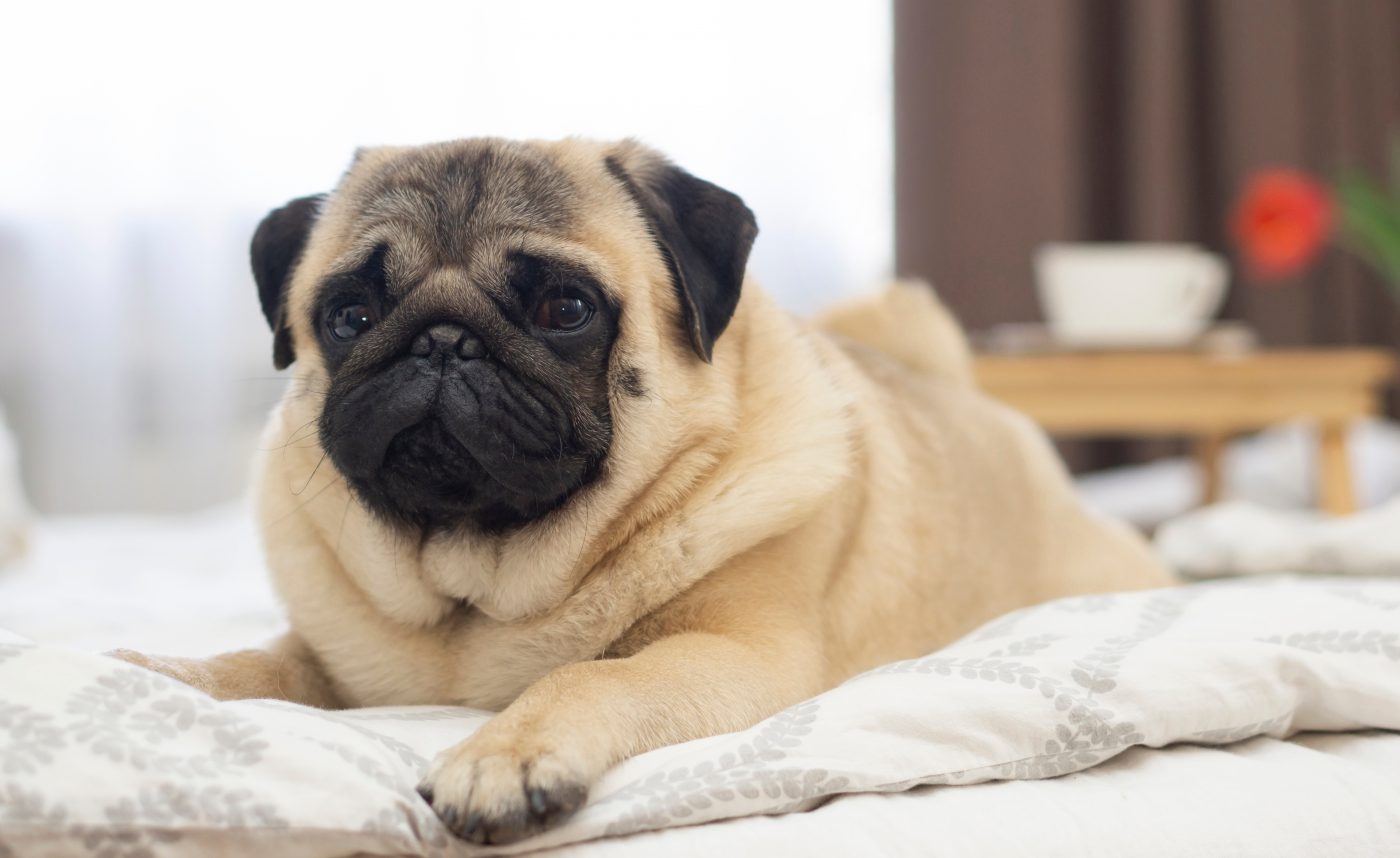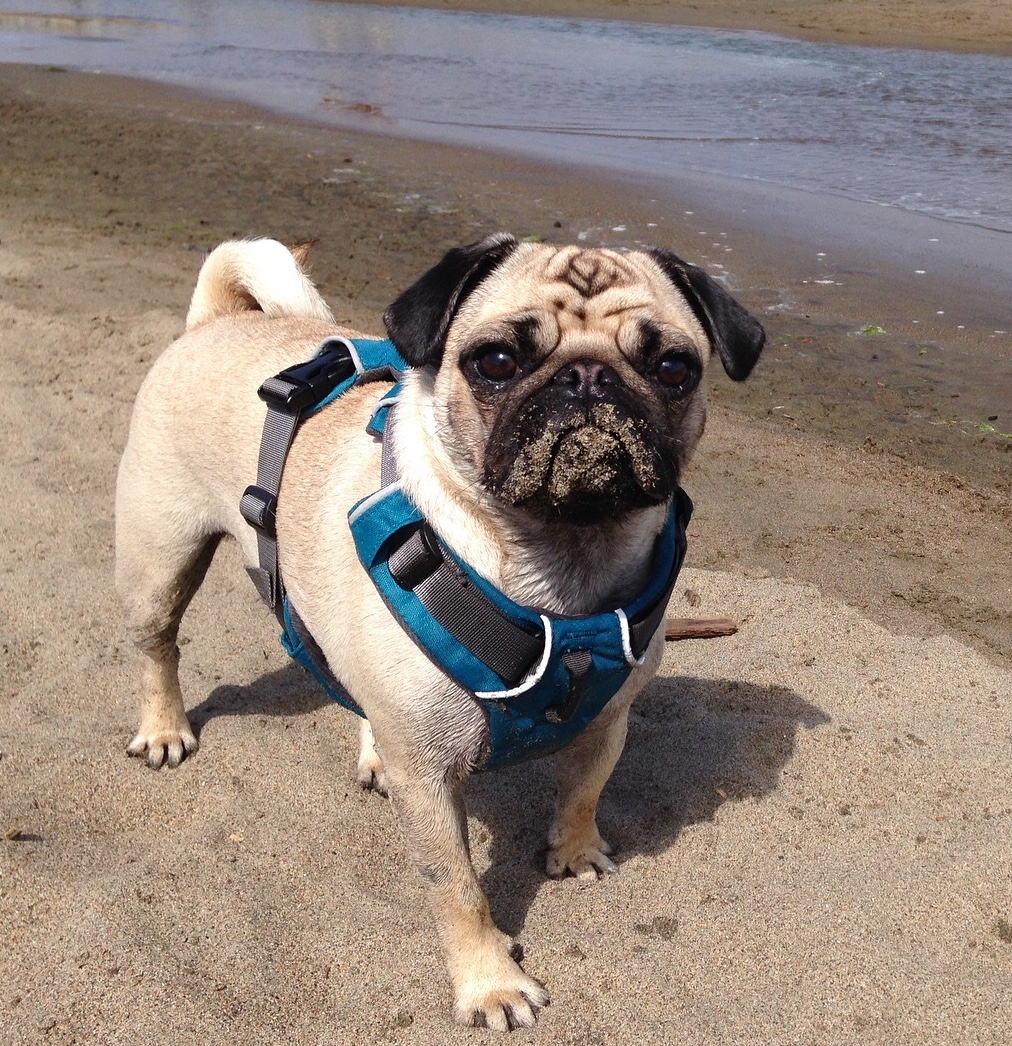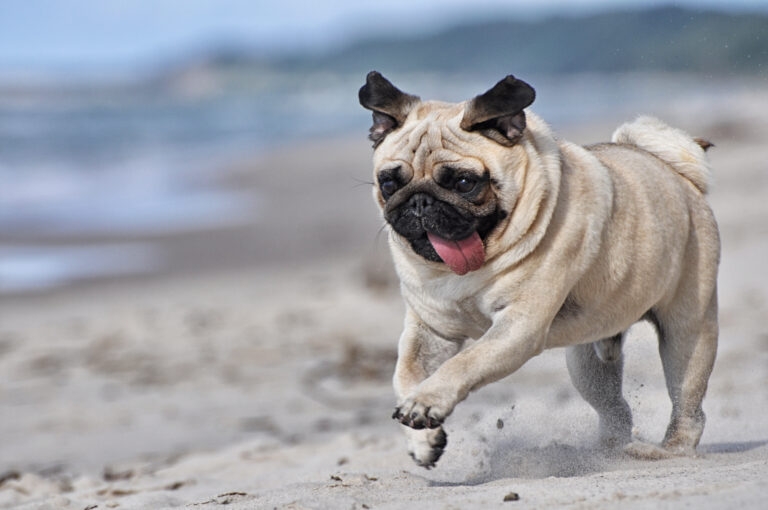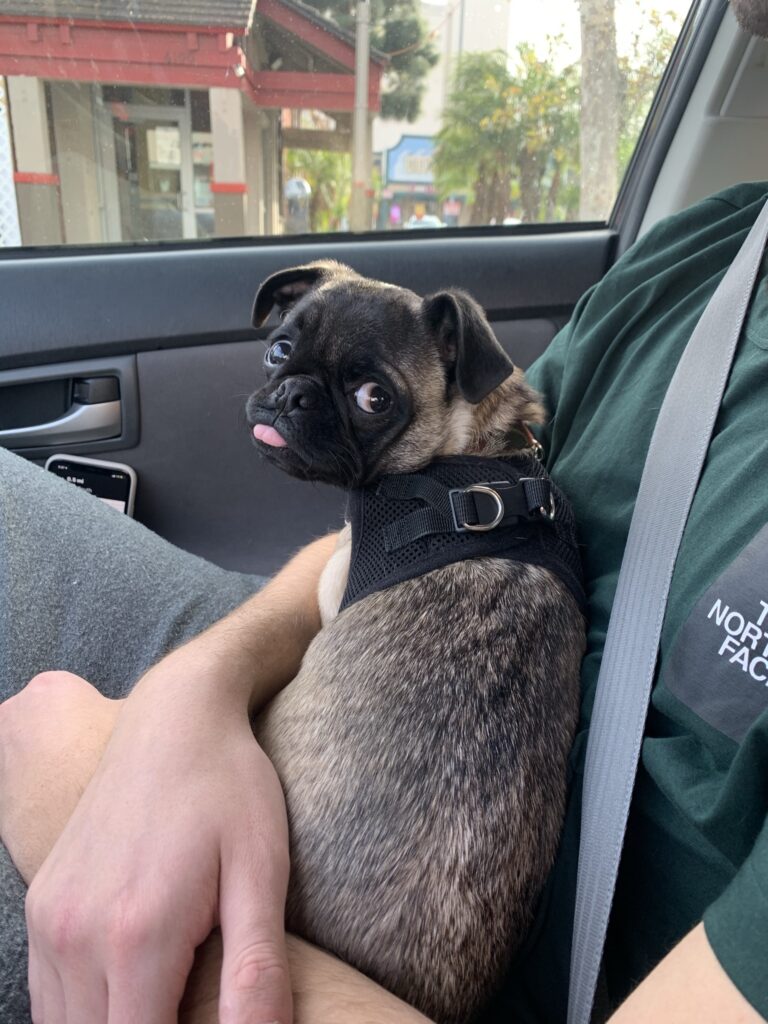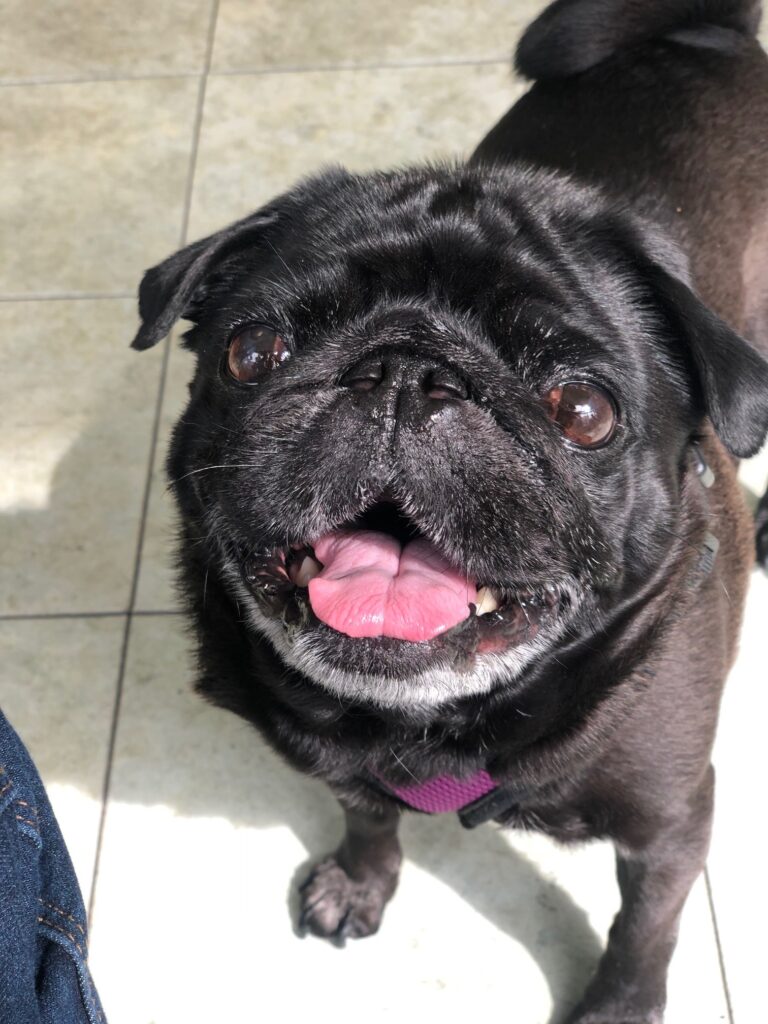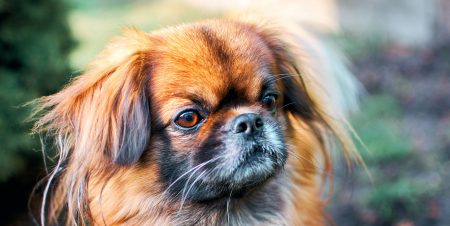With a larger than life personality that’s in perfect contrast to their compact bodies, there’s no canine companion quite like the affectionate, playful pug. Immediately recognizable thanks to their flat-faced, wide-eyed visage and curled tail, pugs have been one of humanity’s funniest friends since they were first bred in China over 2,000 years ago. But with their unique features come unique challenges in proper care.
Read on if you’re considering making a pug a member of your family.
The canine class clown
Goofy, loving, and always the center of attention, pugs are were bred to be companions, and are happiest hanging out with their people, whether that means going on a neighborhood walk or taking an afternoon nap on the couch. They must be included in everything—and we mean everything. While all companion dogs like being by their owner’s side, pugs take this desire to the next level. Prone to separation anxiety, pugs cannot be left to their own devices for very long and would strongly benefit from crate training to help them become more independent and spend time happily alone. The fact of the matter is that, funny and sweet as they are, pugs are sensitive and require a lot of care and attention from their people.
And don’t worry about wondering what your pug is thinking. They will be sure to let you know with a signature pug head tilt, moving their large, round heads this way and that as you speak to them. Pugs are also known for having a quiet bark but a loud scream, almost akin to a shrieking human, most often occurring when they’re in an uncomfortable situation, such as a nail trim.
Pugs tend to like everyone they meet including kids. dogs of any size, or even cats. A well-socialized pug wants to say hello to just about everyone they encounter, and they definitely want to play. While not exactly elite athletes, pugs do love the mental stimulation that comes from learning new tricks, playing with squeaky toys, and even just zooming around with a friend.
“Penny has several classic pug behaviors. She tilts her head whenever you speak to her as if she is saying, ‘really? Is that so!’ Another is her very expressive use of her paws. Penny will paw at us when she needs something and can be very persistent with it.” — Penny the pug’s owner, Veronica M
That said, due to their brachycephalic (short-snouted, flat-faced) anatomy, pugs can have trouble breathing and regulating their body temperature. That means they’re not good candidates for intense physical exercise like running and hiking, and you should never expose them to temperatures above 70 degrees for more than 15-20 minutes at a time. Their extreme anatomy is also why they snort and snore so frequently—the noise is a hallmark of the breed. The occasional snort is normal for this breed, but if your pug starts to wheeze or can’t stop snorting, consult a vet immediately.
Basic pug facts
The largest member of the AKC-defined toy group, full-grown pugs stand about 10-11 inches tall at the shoulder and weigh anywhere from 14 to 18 pounds. They’re sturdy and square in body but with relatively long legs. They are famously flat-faced with a wrinkled mug and back, and a coiled tail to complete the package. Pugs come in two official coat colors: fawn (which ranges from a rare silver to a warmer apricot) with a black muzzle and ears, and all-black.
The ancient, royal history of the pug
The flat-faced pug has a long history dating back several thousand years. Emerging in China around 400 BCE, the pug is believed to have originated from the Lo-Sze, a now-extinct flat-faced dog with short legs, and is considered a Fu dog, or a mythical lion-dog meant to protect palaces and temples and ward off negative energy.
Initially bred as royal companions, pugs have always understood their role as entertainers and friends who deserve to be spoiled. Similar to another flat-faced Chinese breed, the chow chow, one myth holds that a Chinese emperor and his family so loved their pugs that they gave them their own royal escort and military protection.
“His snores are no joke! Sometimes his snores sounds like they are coming from a grown man.”— Mikey’s human, Rachel
They weren’t just beloved in China, however. Pugs were also famously close companions to Tibetan Buddhist monks and, eventually, when they were brought to Europe in the 16th century by Dutch traders, they became the breed of choice for royals all over the continent. Everyone from Prince William of Orange, who made the pug the official dog of the Dutch royal family after his dog Pompey alerted him to assassins, to Marie Antoinette and even Queen Victoria kept pugs.
First introduced to the U.S. after the civil war, pugs were recognized by the AKC in 1885 and have enjoyed considerable popularity among U.S. dog owners ever since, thanks to their easygoing personalities and small stature.
Pug training and exercise
Pugs are people pleasers, so they can take to training. That said, pugs are insistent and they have a tendency to paw at their people until they get what they want. Some pug owners report willfulness during training. It’s important to start socializing and training your pug as early as possible, and maintain consistent training. Start teaching them basic commands on day one, such as sit, stay, and lay down. Try to avoid the “cute excuse”—ignoring bad behavior from adorable smaller dogs as “harmless,” as it can quickly escalate into a bigger problem. And as pugs love a cheeky snack and lack boundaries, teaching them “leave it”—a key command for any dog—is especially important.
“Pugs always act like and look like they are happy–Jake is no exception to this! He loves to walk, and early on he could easily do 3 – 4 miles. Even at 10, he walks 1 – 1 ½ miles every day.” — Jake the pug’s owner, Carol K
Most importantly, don’t let their love of lazing about fool you—pugs require significant physical and mental stimulation every day. Pugs are prone to obesity and joint problems, and as such, healthy adult pugs should exercise for about 60 minutes per day, including indoor play. Feel free to keep each session short, no more than 15 to 20 minutes at a time, to avoid overheating or overexertion, and always bring water and a collapsible bowl with you whenever the temperature is above 70 degrees.
“I wish we knew how funny pugs are before adopting Griff. Now we want more pugs. They really are little clowns. They love kids, love to play, and definitely run the show!” — Griffin the pug’s owner, Roberta B
Grooming and skincare
When adopting a pug, one might think, they’re small and short-haired, so that should mean minimal grooming. But looks can be deceiving—pugs require a relatively robust grooming routine to maintain optimal skin and coat health.
Brushing: Pugs shed. A lot. Their short coats may give the impression that they’re low maintenance—after all, other short-haired dogs like French bulldogs and pit bulls don’t require much hair care—but that’s not the case here. Pugs need weekly or twice-weekly brushing, and during the height of shedding season (summer), you may need to brush them daily to keep up with the amount of fur they cast off.
Nails: No dog likes getting their nails trimmed, but pugs are notorious for putting on the dramatics during nail trimmings, wailing, shrieking, and squirming. It’s essential that you start a nail trimming routine as soon as you bring home your pug to get them used to the sensation and minimize future struggles.
Wrinkles: One of the most endearing features of the pug is their wrinkled face and body and their curled tail. But their wrinkles—and, frankly, all of their nooks and crannies—are a great place for bacteria and yeast to grow, leading to chafing, itching, discomfort, thinning hair, inflamed skin, and even, in some severe cases, open wounds. Clean out their wrinkles anywhere from once a day to once a week, depending on how often they get dirty. You can use a vet-approved wipe or soap and a cotton ball. Separate the wrinkles and run a wipe along the inside of their wrinkles. Be sure to dry the wrinkles afterwards so no water gets trapped (which will create a moist bacteria breeding ground). And always be sure to dry their wrinkles after bathing.
Bathing: Pugs also need baths, about once a month, to maintain healthy skin, because they are prone to skin allergies and conditions such as dermatitis. Similar to wrinkle cleaning, use unscented soap specially formulated for sensitive canine skin and warm water. And after bath time, be sure to give them extra love, as these dramatic dogs might just think the world is ending the moment the water hits their fur (more tips on making bathtime less stressful here).
Common health concerns for pugs
Allergies: Pugs are prone to both food and environmental allergies. Common symptoms include excessive scratching, licking paws, scaly or raw skin, and even diarrhea. Pugs’ wrinkly faces are also prone to dermatitis, a skin condition whose signs include itching, thinning of fur, and redness. Be sure to keep your pug’s wrinkles clean and dry, and consult your vet about medicated shampoos and wipes, which can help reduce and prevent infection.
Brachycephalic Airway Syndrome: As with all brachycephalic dogs, pugs have less runway to bring oxygen into their bodies. Though their skulls are shorter, they have the same amount of soft tissue making up their airways as regular snouted dogs, meaning often their airways are at least partially obstructed, hence all the snorting, wheezing, and snoring.This puts pugs at risk for severe respiratory distress, and may require surgical intervention, especially if they have narrowed nostrils.
Dental problems: Pugs, like many small dog breeds, are more susceptible to periodontal disease due to overcrowded teeth, though a vet may need to perform x-rays to detect it. Untreated periodontal disease can lead to discomfort, tooth loss, and even more serious health problems, such as heart disease. Have your vet regularly examine your dog’s teeth during check-ups, get professional cleanings as needed, and start a daily tooth-brushing routine at home.
Eye problems: Owing to the shape, size, and placement of a pug’s eyes—they have a shallow eye socket which allows their eyeballs to bulge excessively—they are prone to a number of eye problems such as corneal ulcers, dry eye, conjunctivitis, and even proptosis, a trauma-response condition where the eye pops out of its socket completely. Some conditions, such as corneal ulcers, require medical intervention in the form of medicated drops; still others, like cherry eye and proptosis (which typically happens after a physical injury) require surgery. Some vets recommend protective goggles on walks or hikes—especially for adventurous pups prone to eye injury. Monitor your pug’s peepers and speak to your vet at the first sign of red, squinty, itchy, goopy, or otherwise unwell eyes.
Gait abnormalities: Gait abnormalities are relatively common among the breed thanks to their shortened spine and long legs.
Heat stroke: Due to their short snouts, pugs have trouble regulating their body temperature. That means it’s extremely difficult for them to remain cool in higher temperatures. As such, they’re prone to heat stroke, especially when exposed to temperatures above 70 degrees for more than 15-20 minutes. Signs of overheating include excessive panting, glassy eyes, pale gums, and disorientation. Heat stroke can be deadly if not treated immediately.
Obesity: While obesity is a problem for all dogs, with about half of American dogs being reported as overweight or obese, it’s a particular problem for pugs. Obesity can compound the joint problems to which they’re prone, and it’s much easier for a small, food motivated dog such as the pug to put on the pounds.
Pug Dog Encephalitis (PDE): PDE is a neurological condition that typically affects pugs under the age of seven. It’s an inflammation of the brain tissue that can cause discomfort and even seizures and death.
Get pet insurance
Like other brachycephalic dogs, such as French bulldogs, pugs require special care, and sometimes their vet bills can be higher than other breeds thanks to their flat faces, protruding eyes, and predisposition to certain genetic conditions. Because there is a higher incidence of many health conditions among pugs, insurance can save you thousands of dollars and secure necessary medical care for your dog should they need it down the line.
Feeding your pug
Many of the health problems to which pugs are prone—like joint issues, skin and food allergies, dry, itchy skin, and obesity—can either be exacerbated or alleviated by diet.
Maintaining weight: Obesity is not merely an aesthetic issue: it can exacerbate the joint problems common in this breed, and increase the likelihood of developing conditions such as diabetes and cancer—all of which can seriously impact your dog’s quality of life.
Healthy food, in the right amount, is especially important for pugs who, owing to their small stature, are more at risk of developing obesity-related issues and for whom each additional pound is a big deal.
While it may seem difficult to manage the calorie intake and nutrition needs of such a food motivated breed, one simple way to ensure you’re feeding your dog a diet that suits their needs is putting them on a fresh food plan, which comes in pre-portioned packs based on each dog’s specific needs.
Mind the teeth: Crunchy kibble is often said to clean teeth, but it does no such thing. In fact, kibble is an ultra-processed food and as such can contain substances that actually fuel inflammation in the body, including in the tissues of the mouth. Most kibble is starchy and full of fillers that break down to sugar, which contributes to plaque and bacteria. Eating for dental health means eating for overall health—a fresh, whole-food diet promotes a healthier immune system, which helps ward off the dental maladies common in this breed.
Where to get a pug
If you have decided to get a pug of your own, be sure to check out a pug rescue, or an animal shelter near you, or online.
What pug owners say about fresh food
“A few years back, he started developing some strange stomach issues that seemed to be gastrointestinal. Every now and then, he’d get really gassy and uninterested in his food around meal time (never a good sign for a pug!) or he’d try to eat and immediately get sick. We tried mixing up a few different things—supplements, meal timing, more/less exercise—and nothing seemed to do the trick. We learned about The Farmer’s Dog on Instagram and decided to give it a try. Not only was Bean immediately OBSESSED with his delicious new food, but his gastro issues immediately subsided. Over the past few years since he’s been enjoying The Farmer’s Dog, his stomach issues have almost completely resolved, which has been amazing.” — Bean’s owner – Lisa R



